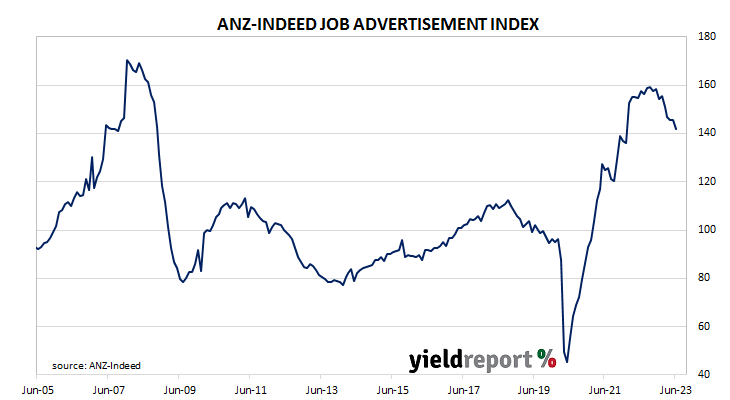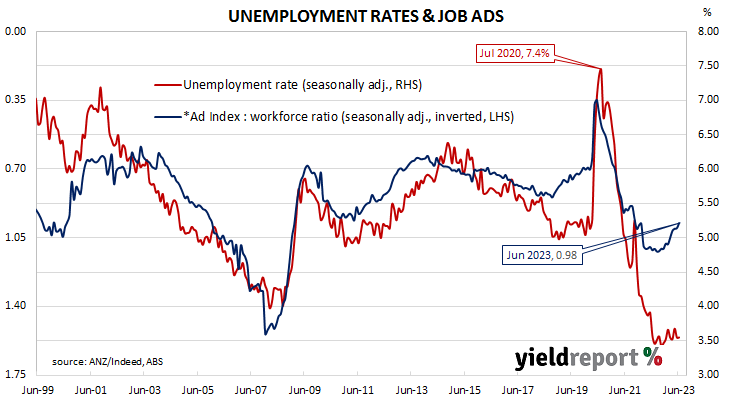Summary: Job ads down 2.5% in June; 10.0% lower than June 2022; ANZ: still 47.5% higher than pre-pandemic levels; ACGB yields down noticeably; rate-rise expectations soften; ANZ: direction of change is clear; ad index-to-workforce ratio falls to 0.98.
From mid-2017 onwards, year-on-year growth rates in the total number of Australian job advertisements consistently exceeded 10%. That was until mid-2018 when the annual growth rate fell back markedly. 2019 was notable for its reduced employment advertising and this trend continued into the first quarter of 2020. Advertising plunged in April and May of 2020 as pandemic restrictions took effect but then recovered quite quickly to historically-high levels.
According to the latest ANZ-Indeed figures, total advertisements fell by 2.5% in June on a seasonally adjusted basis. The result followed 0.1% gain and a 0.9% loss in May and April respectively. On a 12-month basis, total job advertisements were 10.0% lower than in June 2022, down from May’s revised figure of -5.9%.
“Despite the dip, Job Ads are still 47.5% higher than pre-pandemic levels and the labour market remains very tight,” said ANZ economist Madeline Dunk.
The figures came out on the same day as several other reports and Commonwealth Government bond yields fell noticeably. By the close of business, 3-year and 10-year ACGB yields had both decreased by 6bps to 3.93% and 3.96% respectively while the 20-year yield finished 8bps lower at 4.22%.
In the cash futures market, expectations regarding further rate rises softened. At the end of the day, contracts implied the cash rate would rise from the current rate of 4.07% to average 4.135% in July and then to 4.275% in August. February 2024 contracts implied a 4.505% average cash rate while May 2024 contracts implied 4.45%, 38bps more than the current rate.
“Businesses continue to report that labour is the biggest constraint on their output and there were 432,000 job vacancies in Q2,” Dunk added. “It will take time for the labour market tightness to ease. But the direction of change is clear and we expect an ongoing and orderly moderation in Job Ads.”
The inverse relationship between job advertisements and the unemployment rate has been quite strong (see below chart), although ANZ themselves called the relationship between the two series into question in early 2019. A lower job advertisement index as a proportion of the labour force is suggestive of higher unemployment rates in the near future while a rising ratio suggests lower unemployment rates will follow. June’s ad index-to-workforce ratio fell from 1.00 in May to 0.98 after revisions.
In 2008/2009, advertisements plummeted and Australia’s unemployment rate jumped from 4% to nearly 6% over a period of 15 months. When a more dramatic fall in advertisements took place in April 2020, the unemployment rate responded much more quickly.



